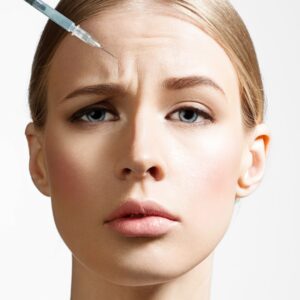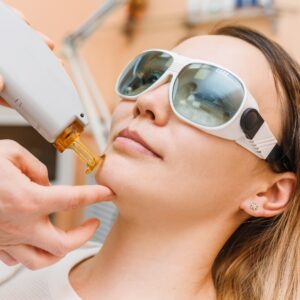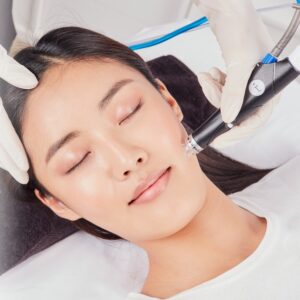Looking for a little R ‘n’ R for your face? Sometimes small ‘tweakments’ are all you need to freshen your complexion and amp up your confidence.
 Anti-wrinkle injections
Anti-wrinkle injections
Quick facts
- Smooths away crow’s feet, forehead lines and the ‘11’s’ between the eyes
- Brow lift effect
- Jawline slimming
What is it?
Known under the brand names Botox, Dysport and Xeomin in Australia, botulinum toxin is single-handedly the most popular aesthetic treatment. Botulinum toxin works by blocking nerve stimulation to wrinkle-causing muscles, which prevents the muscle from contracting and smooths away wrinkles and fine lines.
What does it treat?
As a muscle relaxant, it is used to treat crow’s feet around the eyes, the frown lines between the eyebrows (glabellar lines) and the worry lines across the forehead. It can also be used to produce the effect of a brow lift by relaxing the muscles that drag down the brow and even in the masseter muscle to create a slimmer- looking jawline.
What can I expect?
A few tiny injections are administered into the lower layer of skin and the results kick in around Day 4 or 5, reaching their full result around 2 weeks and lasting on average for about 4 months.
The procedure usually takes around 10 minutes and is generally well tolerated in terms of discomfort – so much so that numbing cream isn’t required.
Fillers
Quick facts
- Used to add volume to cheeks, midface, temple hollows and lips
- Fills in static lines, wrinkles, depressions and scars
What are they?
Fillers are used to add volume and structure, fill deep folds, and smooth fine lines and wrinkles. They vary in longevity, composition and viscosity but all are gel-like in consistency and use a substance called hyaluronic acid, which is found naturally in the body and can absorb up to 1,000 times its own weight in water.
What do they treat?
There are different grades of fillers designed for use in different parts of the face and for different purposes – from creating fuller lips, revolumising sagging areas of the face, and filling in marionette lines, nasolabial folds and temples.
Fillers can be injected superficially to add volume to lips, fill in fine lines, reduce under-eye circles and hollows, or more deeply to ‘sculpt’ the face and add more contour, projection, symmetry and definition to areas such as the cheeks, chin, jawline and even the nose.
What can I expect?
The areas to be filled are numbed with a topical anesthetic, which means you should only feel slight discomfort during a filler procedure.
The type of filler (composition and viscosity), where it’s used and the depth of injection all influence the final result, and how long they last. Superficial ‘soft’ injections for lips, for example, may last up to 6 months, while firmer filler designed for building and contouring and injected deep on the bone can last 12-18 months. Depending on how many areas, this type of procedure will take anywhere from 15 minutes to an hour.
 Microneedling
Microneedling
Quick facts
- Used for overall skin rejuvenation
- Effective for acne scarring and other scarring
- Reduces look of pore size and improves skin texture
What is it?
Skin needling, or microneedling, creates tiny punctures in the skin, resulting in a controlled injury to the skin which stimulates the skin’s natural growth of healthy new skin. The epidermis is left primarily intact so the healing period is quick – which makes it an effective laser or chemical peel alternative for many.
Skin needling can be performed alone, usually with a roller embedded with medical-grade sterile micro- needles. For more dramatic lifting and toning results, radiofrequency (RF) micro needling devices combine the collagen-boosting, skin resurfacing effect of skin needling with the skin- tightening technology of RF energy.
What does it treat?
Microneedling can improve the appearance of wrinkles, scars, stretch marks, skin texture and premature ageing. By stimulating the production of collagen and elastin, skin becomes more even-toned and plump with a youthful-looking glow.
What can I expect?
Microneedling generally causes some discomfort, particularly when performed with radiofrequency, but does not necessarily hurt. A numbing cream is applied before the procedure to minimise this.
After treatment, skin is red and swollen for around one to two days, with a light graze-like scabbing effect forming over the treated area on day two of recovery. Most people are able to return to work and normal activities within a day or so of treatment.
Multiple treatments are usually necessary to achieve significant improvement in the appearance and depth of lines and scars. Treatment effects are cumulative and can be seen six to eight weeks after the initial treatment with long-lasting results.
Skin tightening
Quick facts
- Non-surgical facelift effect
- Tightens and tones lax skin
What is it?
Energy-based treatments for facial lifting and skin tightening are increasingly popular. These devices commonly use a form of energy (heat) such as radiofrequency or ultrasound waves – to target deeper levels of the dermis to promote the production of new collagen formation and remodelling.
What does it treat?
The procedure improves skin texture and reduces sagging skin, as well as improving drooping eyes, jaw line and neck, and softening wrinkles around the mouth, eyes and forehead.
What can I expect?
Non-surgical skin tightening treatments heat the skin’s deep dermis and subdermal layers without damaging the outer layers of the skin.
These types of procedures are associated with some discomfort. Many people report feeling warm pulses under the skin, but this does vary between patients and the type of device used. Your practitioner will give you a better handle of what to expect and will make sure you’re comfortable during treatment.
There may be some swelling and redness that gradually subside over the next few days but in general most patients experience little or no downtime. Results are usually gradual, as the new collagen forms over the next couple of months, and are typically long lasting – up to two years.
 Laser skin resurfacing
Laser skin resurfacing
Quick facts
- Used for overall skin rejuvenation
- Great for sun damage, scarring, lines and wrinkles, anti-ageing, pigmentation
What is it?
Laser is an acronym for Light Amplification for the Stimulated Emission of Radiation and is used in the beauty and aesthetics industry for an array of treatments, ranging from the correction of skin irregularities, pigmentation and wrinkles to hair reduction.
Laser therapies work by targeting tissue. The target tissue for pigmentation is melanin, for spider veins it is blood and for wrinkles it is water. Each of these target tissues absorb a different wavelength of light, meaning a different laser is needed for each specific problem.
The advent of fractionated laser – where microscopic columns of skin are treated while surrounding skin is left intact – made it possible to achieve results comparable to traditional CO2 laser resurfacing (which can take years off your appearance) with fewer side effects and significantly less downtime. These lasers work by creating microscopic thermal injuries that trigger collagen production, stimulating cell renewal and plumping out the tissues.
While not a laser, Intense Pulsed Light (IPL) is another popular light-based therapy for skin rejuvenation. It penetrates deeper into the skin than a non-ablative laser and does not injure the surface, so there is usually no downtime. It can improve skin texture and colour as well as reduce pore size. IPL can effectively treat some types of hyperpigmentation, including age spots and freckles.
What does it treat?
Specific to skin, the benefits of laser treatment include improving evenness
of skin tone and texture, reducing pore size and the appearance of lines and wrinkles, pigmentation, rosacea and scarring, and helping to reverse the effects of sun damage.
What can I expect?
Fractionated laser resurfacing is typically well tolerated. Numbing cream is applied to help minimise any stinging or burning sensation.
A milder treatment may take several sessions, while one procedure is
usually sufficient for a more aggressive treatment. You should expect some redness, swelling and stinging like a bad sunburn, depending on the type of laser used (ablative vs non-ablative) and the depth of treatment. This should continue to dissipate over the hours and days following the procedure. You may also see some of the treated skin begin to slough during the healing process, revealing the new skin underneath.
Recovery time is generally between one and four days, but it shouldn’t prevent you from doing normal daily activities.
You should be able to see improvement in the texture and tone of your skin within the first week, but it will take around 3 months for the final results to be apparent as new collagen and elastin is formed.
 HydraFacial
HydraFacial
Quick facts
- Gentle, quick skin rejuvenation • Instant results
What is it?
Creating a brand-new category in skin health and beauty, HydraFacial is an in-clinic treatment that uses a unique delivery system to cleanse, extract and hydrate – all in in one quick, easy and pleasant treatment.
It uses patented hydradermabrasion technology to deeply cleanse and gently exfoliate the skin, advanced vortex extraction technology to remove debris from pores and deliver intense moisturisation, alongside an infusion of hyaluronic acid, antioxidants and vitamins that work to restore, plump and hydrate the complexion.
What does it treat?
Suitable for all skin types, HydraFacial improves the appearance of fine lines, wrinkles, congested and enlarged pores, oily or acne prone skin, hyperpigmentation and brown spots.
Each treatment creates an instant ‘wow factor’ in terms of brighter, smoother and more radiant skin.
What can I expect?
Expect an instantly gratifying glow in just three steps and 30 minutes, with no discomfort and no downtime. [A]A














